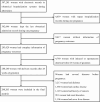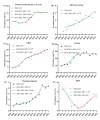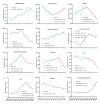Trajectories tracking of maternal and neonatal health in eastern China from 2010 to 2021: A multicentre cross-sectional study
- PMID: 38515427
- PMCID: PMC10958191
- DOI: 10.7189/jogh.14.04069
Trajectories tracking of maternal and neonatal health in eastern China from 2010 to 2021: A multicentre cross-sectional study
Abstract
Background: China's fertility policy has dramatically changed in the past decade with the successive promulgation of the partial two-child policy, universal two-child policy and three-child policy. The trajectories of maternal and neonatal health accompanied the changes in fertility policy are unknown.
Methods: We obtained data of 280 203 deliveries with six common pregnancy complications and thirteen perinatal outcomes between 2010 and 2021 in eastern China. The average annual percent change (AAPC) was calculated to evaluated the temporal trajectories of obstetric characteristics and adverse outcomes during this period. Then, the autoregressive integrated moving average (ARIMA) models were constructed to project future trend of obstetric characteristics and outcomes until 2027.
Results: The proportion of advanced maternal age (AMA), assisted reproduction technology (ART) treatment, gestational diabetes mellitus (GDM), anaemia, thrombocytopenia, thyroid dysfunction, oligohydramnios, placental abruption, small for gestational age (SGA) infants, and congenital malformation significantly increased from 2010 to 2021. However, the placenta previa, large for gestational age (LGA) infants and stillbirth significantly decreased during the same period. The AMA and ART treatment were identified as independent risk factors for the uptrends of pregnancy complications and adverse perinatal outcomes. The overall caesarean section rate remained above 40%. Importantly, among multiparas, a previous caesarean section was found to be associated with a significantly reduced risk of hypertensive disorders of pregnancy (HDP), premature rupture of membranes (PROM), placenta previa, placental abruption, perinatal asphyxia, LGA infants, stillbirths, and preterm births. In addition, the ARIMA time series models predicted increasing trends in the ART treatment, GDM, anaemia, thrombocytopenia, postpartum haemorrhage, congenital malformation, and caesarean section until 2027. Conversely, a decreasing trend was predicted for HDP, PROM, and placental abruption premature, LGA infants, SGA infants, perinatal asphyxia, and stillbirth.
Conclusions: Maternal and neonatal adverse outcomes became more prevalent from 2010 to 2021 in China. Maternal age and ART treatment were independent risk factors for adverse obstetric outcomes. The findings offered comprehensive trajectories for monitoring pregnancy complications and perinatal outcomes in China, and provided robust intervention targets in obstetric safety. The development of early prediction models and the implementation of prevention efforts for adverse obstetric events are necessary to enhance obstetric safety.
Copyright © 2024 by the Journal of Global Health. All rights reserved.
Conflict of interest statement
Disclosure of interest: The authors completed the ICMJE Disclosure of Interest Form (available upon request from the corresponding author) and disclose no relevant interests.
Figures










References
-
- National Bureau of Statistics the People’s Republic of China. Statistical Bulletin of the People's Republic of China on National Economic and Social Development for 2016. Available: http://www.stats.gov.cn/sj/zxfb/202302/t20230203_1899428.html. Accessed: 28 Februry 2017.
-
- National Bureau of Statistics the People’s Republic of China. Statistical Bulletin of the People's Republic of China on National Economic and Social Development for 2017. Available: http://www.stats.gov.cn/sj/zxfb/202302/t20230203_1899855.html. Accessed: 28 Februry 2018.
-
- National Bureau of Statistics the People’s Republic of China. The Seventh National Census. Available: https://www.stats.gov.cn/sj/pcsj/rkpc/7rp/indexch.htm. Accessed: 11 May 2021.
Publication types
MeSH terms
LinkOut - more resources
Full Text Sources
Medical
Miscellaneous
